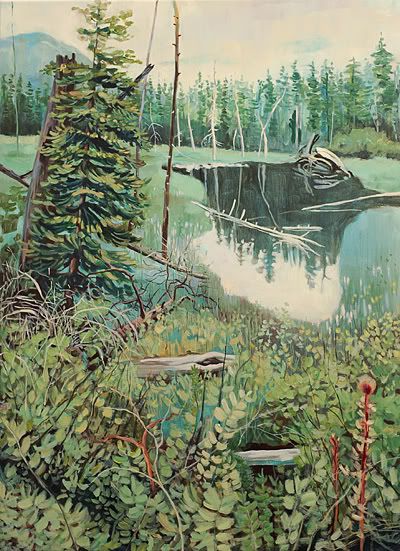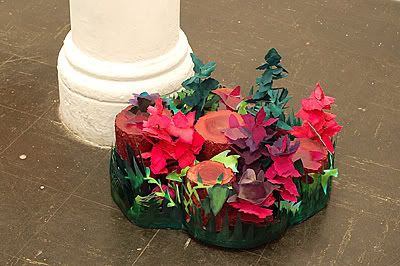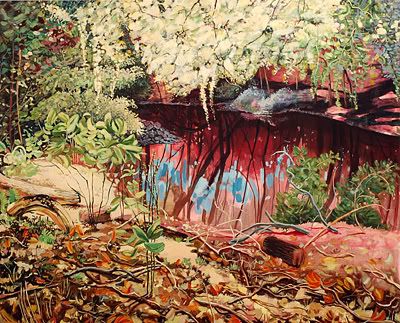
Amy Talluto
"Silver Pond/Montana"
2006
Oil on canvas
44 x 32 inches
"Out of This World," currently on view at PS122 Gallery, is a two-person exhibition featuring sculptures and photographs by Diane Carr and paintings by Amy Talluto. Although landscape is a principal subject matter for both Carr and Talluto, their approaches are distinct.

Diane Carr
"Forest Floor"
2006
Ink, paper, plastic, foam, resin
14 x 24 x 22 inches
Carr's sculptural vignettes depict woodland glades, starry ponds, icy slopes, or tree covered hillsides, but these pleasant scenics are fashioned of foam, plastic, resin, and painted paper. The brilliant, even startling colors Carr uses are at once poisonous and magical, acidic and jewel-like. Initially, viewers may want to plunge into these cartoon worlds just as they did their childhood day dreams, but there is an air of toxicity about Carr's sculptures. Like the beautiful poison dart frog, the works' vivid coloring seems to say, "Look, but don't touch."
The opening line of the poem "Son," by Brad Leithauser, states that "Memory buries its own." I recall this line as I consider Carr's landscapes. Her body of work is as concerned with memory and longing - otherwise known as nostalgia - as it is with the juxtaposition of natural and unnatural. How do we treat our buried memories? How do we fashion our memories to suit our purposes, or to fit our desired narrative? Likewise, how will we remember this moment? Carr's sculptures are elegies for moments past, but also for the present, reminders that what is will not be. Time, so far as we know, is unremitting.

Amy Talluto
"Pond"
2006
Oil on canvas
60 x 74 inches
Talluto's accomplished oil paintings can be deemed "traditional landscapes," but her choices suggest she is less interested in painting a pond per se, than she is in unfolding and interpreting that pond. Where one expects space to recede, for example, it might suddenly flatten, or perhaps the contour of a reflection lifts, causing the foreground to recede as our brain tries to force the imagery back where we feel it "should" reside. In some passages, the effect is vertiginous; if Talluto's paintings are a window onto another world, they frame a domain in which our brain and senses will are addled. By focusing on the riot of color and form, Talluto strives to reveal the animating force, that invisible weave that ties together all things.

Diane Carr
"Winter Forest"
2006
Ink, paper, foam, resin
24 x 22 x 16 inches
Admiring the work in "Out of This World," I think about the increasing number of artists who are returning to landscape. The reappearance of wild scenery in the contemporary gallery is a nod to our ever more domestic culture, one desperately in need of outside pictures for inside walls. What's more, the language many of these contemporary landscape artists use to describe their work is strikingly similar. I've described my recent paintings as "hallucinatory landscapes, sometimes foreboding, sometimes joyous, always ambivalent." In the press release for "Out of This World," Carr writes of her work, "the environments are sometimes peaceful and sometimes ominous in feeling and are a combination of what exists around us." Talluto states that her work is "sometimes bright, lush and flowering...sometimes dissonant, murky and foreboding." Elsewhere, Talluto says, "a shifting psychological mood pervades the group as a whole, moving between realms of magical fantasy, sparkling beauty, anxiety, and the sinister and mysterious." And that's just three of us! I've read many variations on this theme.
On the one hand, it's unremarkable. After all, Nature is ambivalent. Of course it will be "sometimes foreboding" and "sometimes peaceful." Duh. But the ambivalent language used by so many artists, myself included, signals the sublime. It describes landscape that "subverts order, coherence...bypasses the rational mind and concentrates directly on the emotions."(1) For most of the twentieth century, sublime landscape was deemed a goat, an unworthy cliche. Indeed, with a few notable exceptions, landscape artists of all persuasions have been held in low regard by the art world establishment for decades.
These are turbulent times, however, marked by anxiety and uncertainty. The promise of progress is now viewed with much skepticism and people again recognize the inevitability of cycles, and of growth and decay. Moreover, landscape art has a history of flourishing in countries during periods of intense colonialism. This proved true in China, Japan, and Rome many centuries past, and, within the last five hundred years, in Holland, France, Britain, and the United States. Perhaps today, as wars wage on, as nuclear weapons again proliferate, and as global, corporate colonialism becomes the zeitgeist, artists are returning to sublime landscape, to depictions of an ambivalent world that delights and inspires as surely as it destroys and awes.
"You lose yourself in boundless spaces, your whole being experiences a silent cleansing and clarification, your I vanishes, you are nothing, God is everything." That was written by Carl Gustav Carus, in his 1824 "Nine Letters on Landscape Painting." How the pendulum swings!
(1) Malcolm Andrews, Landscape and Western Art, Oxford University Press, 1999
Photo credit: all images courtesy the artists (unfortunately, the reproductions can not do justice to the luminosity of Carr's sculpture)

2 comments:
Yesterday I sat in on a seminar for Painting & Drawing MFA students at UW. The subject was...
That's right, landscapes. Specifically, it was landscape drawing from observation. This was mixed in with discussion of Easter Island (art as war item/ecological destroyer) and Shelley's 'Ozymandius.'
Zeitgeist, I s'pose. I, for one, am pretty excited to see the shift.
This is a wonderful show.
Both artists are original and compelling colorists, and their work is just spectacularly complementary, and harmonious.
Also it's a great little space.
Regarding landscape paintings, is that what everybody wants to do these days? Dang. It's happening to me too, and I hate having anything in common with other people. I think it may just be a reaction to being crammed in here in New York.
Well I am glad you reviewed this show, because that's why I went. Keep on rockin' baby, never give up!
Post a Comment